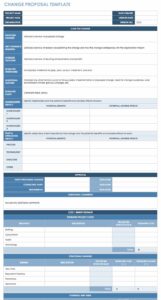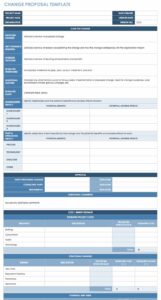Utilizing a structured form for modification proposals offers several advantages. It reduces ambiguity, improves clarity, and streamlines the approval workflow. Standardization ensures all necessary information is captured, minimizing back-and-forth communication and potential errors, ultimately saving time and resources. Clear documentation also contributes to better change management and facilitates tracking.
The following sections will explore the key components of these structured forms, different types for various situations, and best practices for their implementation and use within organizations.
Key Components
Effective modification proposals require specific information for clear communication and efficient processing. Several key components ensure completeness and clarity.
1. Identification: A unique identifier allows for easy tracking and referencing. This typically includes a request number, date, and the requestor’s name and department.
2. Description of Change: A detailed explanation of the proposed modification is crucial. This should clearly articulate the nature of the change, its scope, and the rationale behind it.
3. Justification: A clear justification for the change, outlining the benefits and the reasons for its necessity, supports the request and aids decision-making.
4. Impact Assessment: Potential impacts on existing systems, processes, or stakeholders should be analyzed and documented. This includes potential risks and mitigation strategies.
5. Implementation Plan: A high-level plan outlining how the change will be implemented, including timelines, resources, and responsible parties, demonstrates feasibility and preparedness.
6. Back-out Plan: A contingency plan for reverting the change if necessary is essential for risk management. This ensures a safe and controlled process in case of unforeseen issues.
7. Approval: Designated approval sections provide space for relevant stakeholders to authorize the change. This ensures proper governance and accountability.
Providing comprehensive details across these areas contributes to a well-defined proposal, enabling efficient evaluation and implementation.
How to Create a Request for Change Template
Creating a standardized form for modification proposals involves several key steps. A well-structured template ensures clarity, consistency, and efficiency throughout the change management process.
1. Define Scope and Purpose: Clearly define the scope of the template and the types of changes it will cover. This ensures the template remains relevant and focused.
2. Identify Required Information: Determine the essential information needed for a comprehensive change request. This typically includes identification details, description of the change, justification, impact assessment, implementation plan, back-out plan, and approval sections.
3. Design the Layout: Design a clear and logical layout for the template. Use headings, subheadings, and clear labels for each field to enhance readability and ensure all necessary information is captured.
4. Choose a Format: Select an appropriate format for the template, such as a word document, spreadsheet, or online form. Consider accessibility and ease of use for all stakeholders.
5. Develop Instructions: Provide clear and concise instructions on how to complete the template. This minimizes potential errors and ensures consistency in submitted requests.
6. Test and Refine: Pilot test the template with a small group of users and gather feedback. Use the feedback to refine the template and improve its usability.
7. Implement and Communicate: Roll out the template across the organization and communicate its purpose and usage. Provide training and support to ensure proper adoption.
8. Regularly Review and Update: Periodically review the template and update it as needed to reflect evolving business needs and best practices. This ensures the template remains effective and relevant.
A well-designed, consistently utilized template streamlines change processes, improves communication, and minimizes potential disruptions. Regular review and refinement ensure ongoing effectiveness.
Standardized forms for documenting desired modifications provide a structured framework for clear communication and efficient processing of change proposals. Key components such as detailed descriptions, justifications, impact assessments, and implementation plans ensure comprehensive documentation. Developing well-designed templates with clear instructions and regular review cycles contributes to effective change management practices within organizations.
Leveraging structured approaches to change management fosters better communication, reduces errors, and facilitates smoother transitions. Organizations prioritizing streamlined change processes contribute to increased agility and adaptability in dynamic environments. Effective change management ultimately empowers organizations to embrace improvements and achieve strategic objectives.


